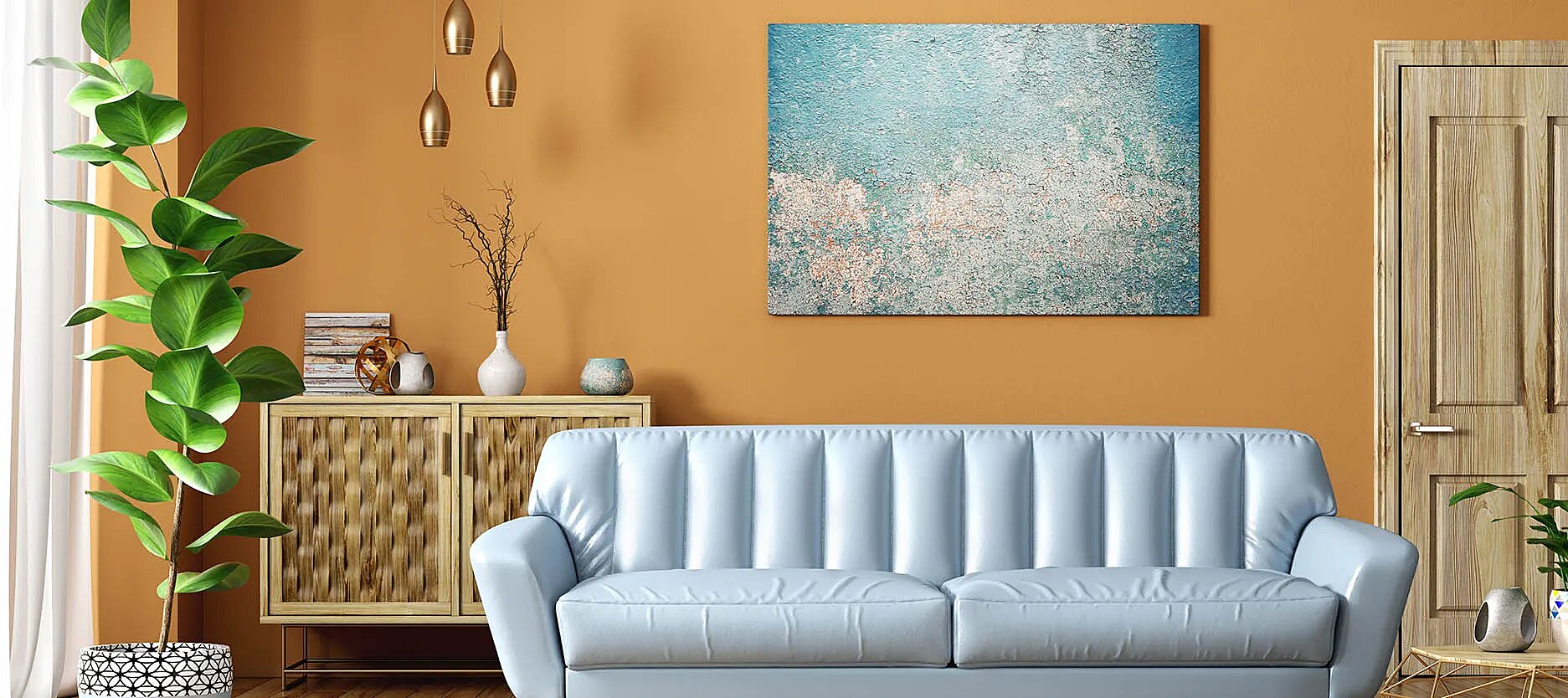What are the Best Colour Schemes for Bedrooms?
Good palettes remain unperturbed in the daytime and warm after the planet sets the sun and goes down. Begin with two silent neutrals and one accent, and repeat each of them on walls, fabrics, and small objects.
- Ivory Walls, Sand Trims, Sage Accent: A restful trio for city apartments. Ivory on main walls, sand on skirting and door frames, sage in cushions and a reading chair.
- Greige With Warm White and Oak: Greige wall colour, warm white ceiling, oak or cane furniture. This looks tidy in mixed natural and artificial light.
- Powder Blue with Chalky White: A light, breezy option for humid coastal areas. Use crisp cotton bedding to avoid a heavy feel.
- Blush Beige, Walnut, and Ecru: Works with darker Indian woods. Use blush beige on three walls, keep the headboard wall in ecru, and let walnut furniture anchor the space.
- Charcoal with Dove Grey and Ivory: Suitable for larger rooms. Put charcoal behind the bed, paint the rest in dove grey, and use ivory sheets to soften the contrast.
- Stone, Taupe, and Brass: A quiet hotel-style palette. Bring in brass through lamps and framed mirrors, not large surfaces.
These combinations are the best room colour schemes because they are simple to maintain and easy to adjust with textiles or art, with a finish such as Nerolac Beauty Little Master Sheen.
How do Bedroom Colour Schemes Affect Mood and Sleep?
Colour has a significant impact on a room’s atmosphere. Soft blues and greens are generally considered relaxing, which is what most people want when they are about to sleep. The colour choices of stone, taupe, and greige are neutral ones, which reduce visual noise and allow the eye to rest.
Rooms with air conditioning are welcoming, featuring cosy accents in terracotta or a warm, mustard hue. Dark tones, such as navy or charcoal, are featured on one wall and are contrasted by warm bedside lighting. Bright colours can be seen as jovial; therefore, they are more suitable for smaller decorations, such as cushions, lampshades, or pictures.
Light temperature matters. Choose warm LEDs for bedside lamps. Add a dimmer so evening light is gentle. Place task lighting in the wardrobe area to avoid harsh glare near the bed. When shortlisting paints, note the product name Neroalc Impressions Kashmir.
Why is Choosing the Best Room Colour Schemes for Small vs. Large Bedrooms?
Scale changes how colours behave.
- Small Rooms: Light blue schemes in the bedrooms reflect light and round corners. Paint the ceiling in the same light colour as the wall so that the wall and the ceiling blend in. When there is storage up to the ceiling, complete shutters with the wall colour finish so that the unit is invisible.
- Large Rooms: Richer tones help big spaces feel comfortable. Use a deeper headboard wall, such as olive or charcoal, then keep the side walls lighter. A darker rug or bedspread grounds the centre of the room and prevents an echoey look.
- Rooms with Low Natural Light: Skip very bright whites that can look grey. Choose warm whites or pale beige with yellow or red undertones. Use layered lighting to avoid harsh shadows.
Also Read: Two Colour Combination for Bedroom Walls
What are the Main Types of Bedroom Colour Schemes?
A quick grasp of scheme types makes selection easier.
- Monochromatic: One colour in several strengths. Example: sky blue, duck-egg, and slate. Calming and seamless.
- Analogous: Neighbours on the colour wheel. Example: blue, blue-green, and green. Smooth transitions that suit restful rooms.
- Complementary: Opposites such as blue and orange or green and red. Use one dominant colour and incorporate the other in subtle touches.
- Split Complementary: One main colour with two neighbours of its opposite. Offers contrast while staying gentle.
- Neutral with Accent: The most practical approach for bedrooms in India. Use whites, greys, taupes, or beiges as the base, then bring a single accent through artwork, cushions, and one painted element.
What are Popular Light Colour Schemes for Bedrooms?
Light palettes pair well with compact floor plans and long, sunny summers.
- Warm White, Oyster, and Seafoam
- Ivory, Mist Grey, and Soft Blue
- Linen, Pearl, and Pale Sage
- Cream, Sand, and Peach-Beige
- Chalk White, Silver, and Powder Pink
Complete these schemes by adding a deeper element, such as a walnut headboard, a charcoal rug, or a dark, woven basket. Use washable or low-sheen finishes to handle dust and monsoon splashes.
Also Read: Two Colour Combination Ideas for Awesome Bedroom Decor
What Speciality Bedroom Colour Scheme Ideas can Make Your Room Unique?
Small, focused moves create personality without visual clutter.
- Two-Tone Walls: Paint the lower two-thirds in a muted colour, such as sage, and the top third in off-white. The room feels taller and more tailored.
- Painted Headboard Panel: Mask a large rectangle behind the bed and paint it one tone deeper than the wall. Frame the bed without buying a new one.
- Soft Ombre: Keep the bottom of the wall slightly deeper and fade to a lighter value near the ceiling in the same colour family.
- Tinted Ceiling: Add a whisper of the wall colour to the ceiling. This ties the palette together while staying airy.
- Micro Accents: Paint a window frame, shelf edge, or small stool in an accent colour. These little notes make bed colour schemes feel designed, not accidental.
- Texture as Colour: Limewash, grasscloth-look wallpaper, or fabric headboards bring depth even when the palette is minimal.
Which Bedroom Colour Scheme Ideas Match Luxury and Premium Interiors?
Luxury often means restraint and finish quality.
- Mushroom, Greige, and Black Accents: Keep lines clean. Use black only in slim frames, lamp bases, and handles.
- Deep Navy, Warm White, and Walnut: A classic combination for premium rooms with tall curtains and a soft wool rug.
- Charcoal, Putty, and Champagne Metallics: Works well with marble or polished stone. Keep metallics brushed rather than glossy.
- Olive Green, Ecru, and Aged Gold: Elegant with mouldings or panelled walls. Balance with natural linen.
- Stone, Taupe, and Brass: Use cove lights and bedside pendants to highlight textures. Avoid using too many small objects to maintain a calm scheme.
How to Choose the Best Room Colour Schemes Based on Your Personality?
Link the palette to the lifestyle so the bedroom reflects how you like to unwind.
- Minimalist: Greige, stone, and white, with only one patterned item. Rely on texture in cotton, linen, and jute.
- Nature Lover: Sage, olive, and wood tones. Add plants, cane baskets, and woven pendants.
- Creative: Muted complementary pairs, such as dusty blue with terracotta. Keep walls calm and express colour through art.
- Classic: Cream, beige, and walnut with block-printed bedcovers and brass accents.
- Modern: Charcoal, pale grey, and mustard or teal. Thin black lines in frames stop the scheme from feeling bland.
- Romantic: Blush, warm white, and antique brass with soft drapery and rounded forms.
Choose two main colours and one accent. Repeat the accent at least three times in visible places so the palette feels intentional.
Which Best Colour Schemes For Bedrooms Suit Couples vs. Kids’ Rooms?
Bedrooms serve different needs. Match the palette and finish to the user.
- Couples: Balanced neutrals make decision-making easier. Linen with taupe and charcoal accents, or stone with sage and walnut, are steady choices. Keep patterns gentle so the room stays restful.
- Young Children: Light main walls with playful movable accents. Warm white walls, sky-blue storage, and a coral reading chair can liven the space without repainting. Choose durable, washable finishes.
- Teenagers: Pastel grey or warm white with a single bold element, such as teal shelving. Provide a pinboard area and a bedside light for late reading.
For any shared space, give each side of the bed a different accent colour within the same palette. The room feels cohesive while still allowing for individual personality.
How to Align Room Colour Scheme Ideas With Vastu or Feng Shui?
Many Indian households like to consider traditional guidance while staying practical.
- North-East Bedrooms: Gentle blues, soft greens, and off white.
- South-West Bedrooms: Earthy tones such as beige, taupe, and terracotta.
- East Bedrooms: Light yellow, peach-beige, or warm white.
- West Bedrooms: Creams and muted greys with a warm accent.
Lay the headboard against a hard wall. Mirrors should not be placed directly facing the bed. Keep it clear and rounded corners where possible to achieve a smoother flow.
How to Apply Bedroom Colour Schemes Effectively?
Execution turns ideas into results. Follow this step-by-step plan.
- Observe Your Light: Stand in the room morning, afternoon, and night. Note which wall receives harsh sun, which corner remains dim, and where you typically read.
- Test Undertones: Paint sample squares at least A4 size on different walls. Live with them for two days. Select a shade that appears balanced across different times of day.
- Set Proportions: Use the 60-30-10 rule. Approximately 60% primary wall colour, 30% of secondary elements, e.g. curtains and rugs, and 10% accent items, e.g. cushions.
- Coordinate with Fixed Elements: Floors, wardrobes, shutters, and the bed are expensive to change. If the flooring is warm, choose warm neutrals. If you have cool stone, cooler greys and blues may sit better.
- Choose Finishes: Matt or low-sheen finishes hide small flaws on walls. Satin or semi-gloss finishes on trims and doors resist scuffs and are easy to wipe clean.
- Layer Lighting: One ceiling light, two bedside lamps, and soft strip lighting behind the headboard cover most needs. Warm white bulbs keep colours gentle at night.
- Style with Textiles: Cotton and linen are ideal for hot months. Combine solids with one pattern, for example, a block-printed bedcover or a quiet stripe.
- Create a Focal Point: A deeper headboard wall, a textured wallpaper panel, or a large artwork gives the eye a place to rest.
How to Maintain and Refresh Bedroom Colour Schemes Over Time?
Keep the palette looking new with these habits.
- Dust near windows and balconies regularly.
- Keep a small pot of wall paint for touch-ups on scuffs and scratches.
- Rotate textiles by season. Use light covers in the summer and richer weaves in the winter.
- Protect your space from strong sunlight with lined curtains or blinds to reduce fading.
- Refresh accents first. Change cushion covers, a throw, and a lampshade in the same colour family for a quick update.
- Record exact paint names, batch numbers, and finishes so you can reorder easily.
Conclusion: How to Blend the Best Room Colour Schemes With Décor for a Dreamy Bedroom
A bedroom feels complete when colour, texture, and light are in alignment. Choose an unbiased colour that corresponds to your floor and natural illumination, and use a complementary colour to fabrics and small items. There should be minimal clutter, and the light must be warm. Whether it is greige with stone, sage with sand, or navy with warm white, a well-picked colour scheme is a terrific way to relax, and it is also a nice way to express your style with ease.


















